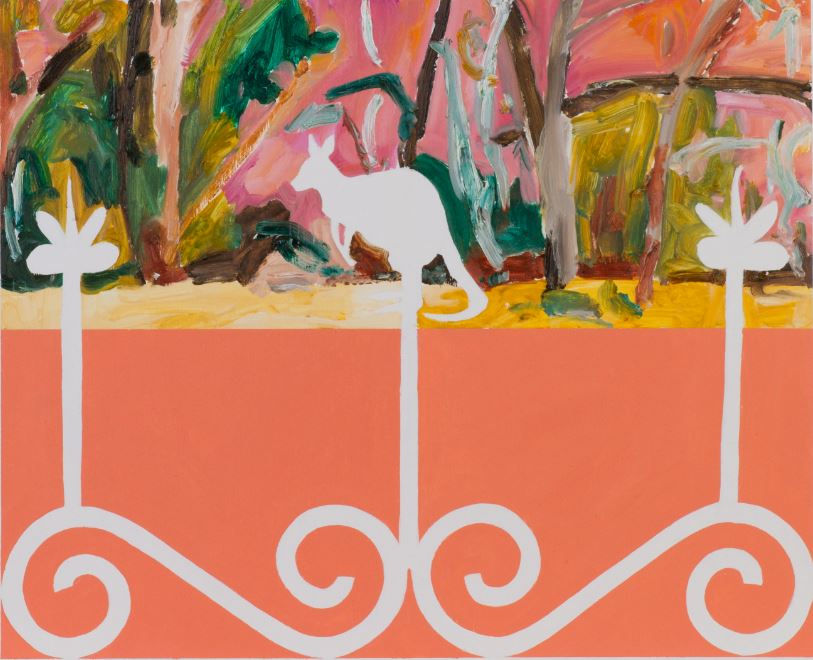Maddison Kitching | A Partial View
- Chapter House Lane
- Jan 18, 2018
- 4 min read
In a sea of grey buildings Kitching boldly tackles our cultural attitude towards the Australian bush. In this series he depicts the placement of the bush in our cultural psyche and it is distinctly separate from ourselves. Divided by a veranda, screen, awning, or fence, the bush is beaten, damaged and dying; populated with discrete silhouettes of animals that are tokenistic, decorative or camouflaged by their innocuous flatness, perhaps even imagined.
This exhibition was a delight to experience especially in context of the hard and cool city environment. If you missed it, jump online, and see how Kitching is building an engaging practice whilst tackling modern colonial Australian culture. I will certainly be on the look-out for his next exhibition.
…
Building on his previous work, Kitching has developed a series of landscape paintings featuring Australian colonial architecture and design that to me depict our cultural attitude towards the Australian bush. He does this through a series of investigations: through content, through composition and medium application, and also through the way he integrates and challenges the principles of graphic design and art.
In all of Maddison’s work in this exhibition we are the voyeur looking out onto a bush scene, and in this particular piece we are looking out from perhaps the gap between a slightly open double-hung window. With the blind partially pulled down, the space we are in is comparatively dark to the sun soaked scene outside. Through the gap we look down a steep gradient through some remnant trees to a sweeping arc that may be a river, or a road.

Maddison Kitching Untitled 2017
Oil acrylic and enamel on ply wood
Courtesy of the artist
Beyond this is a golden yellow plain perhaps a field of wheat, or denuded land affect by drought. The landscape moves under Maddison's brush strokes. It is thrilling to look out and down, yet perched in a bare stubby tree a koala is also looking out and down the hill onto further bare stubby trees and the yellow plain.
The koala provides context to the view. It is small, innocuous; it is a white silhouette, barely there - perhaps imagined. The flatness of the white shape that represents a koala relates to the flatness of the foreground, the window frame and blind; yet the shape sits within the landscape, the background. Playing with meaning, distance, perception and painterly application, the white shape that represents a koala belongs to both worlds, but not to either. Perhaps to the foreground as an interior tokenistic decoration, perhaps also, to the bleak landscape where it would almost certainly struggle to survive.
This example of content is replicated within the exhibition. Each work offers a view outside from differing positions within the colonial home environment, using different animals, colour palettes and landscapes - yet the fundamental framework remains:
- voyeur looking out of a built structure through a ‘lens’, whether it be a window, gate, fence, awning;
- the foreground, or built frame is depicted by flat geometric shapes sourced from patterns found in the oo Australian colonial era home;
- loosely painted landscape in a state of declining health, and,
- flat silhouette animal that relates to the foreground (the interior modern human world) and the exterior (landscape).
Although the above sounds completely simple and lacklustre, I assure you I’ve not spoilt the magic this work offers.

Maddison Kitching Untitled 2017
Oil acrylic and enamel on ply wood
Image courtesy of the artist
The magic of this body of work is nestled in the way Kitching applies paint. By using a combination of hard-line block colour high gloss elements in the foreground to frame the landscape, the loosely applied paint that depicts the landscape is a delightful relief. The combination of these painting styles in the one composition seems visually extreme, however it is also tremendously familiar. So much care and accuracy, considered geometry has been applied to the foreground – the built environment. The background on the other hand seems slapdash, and executed without relative care (a complete farce, of course).
With such divided foreground and background, we toggle between worlds. The silhouette animals teeter between toy, decoration and representing the real thing. What binds these differences is careful colour use and colour selection. Colours that relate and define both the foreground and background are used to create a harmonious relationship within the composition.

Maddison Kitching Untitled 2017
Oil acrylic and enamel on ply wood
Courtesy of the artist
Finally, there is a clear investigative thread throughout Kitchings work between art and design. Below are examples of previous work that perhaps demonstrate the evolution of the relationship he depicts. Each faculty grapples for attention and dominance and perhaps ultimately balance.
Kitchings direct investigation into colonial Australian attitudes towards the bush was the draw card for me – there a very few artists overtly tackling this subject and with such consistency. Using design elements from the structure of colonial homes to represent the ‘lens’ of colonial Australian culture, he also uses these features to challenge design and art principles. Overall I found the exhibition completely refreshing, albeit somewhat ‘tight’. The examples of his previous works for me offer more of an immediacy, flow and feeling. Perhaps this response is exactly what was intended. Regardless, it was tremendously exciting to experience his work and I look forward to what will come next.
…

Maddison Kitching Tourists admire the scenery 2014
Oil and PVA glue on magazine
Courtesy of the artist

Maddison Kitching Untitled 2016
Oil acrylic and enamel on ply wood
Courtesy of the artist

Maddison Kitching Untitled 2017 Oil and enamel on ply wood
Courtesy of the artist
...
Find more information about Maddision Kitching.
This exhibition is a Chapter House Lane exhibition.
Maddison Kitching | A Partial View
18 January to 24 February 2018
...


Comments